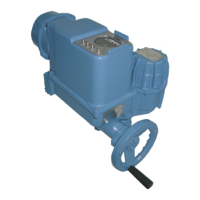
Do you have a question about the AUMA DREHMO i-matic and is the answer not in the manual?
| Brand | AUMA |
|---|---|
| Model | DREHMO i-matic |
| Category | Controller |
| Language | English |
General safety information, standards, directives, qualification of staff, and commissioning checks.
Defines the intended use and prohibited applications for DREHMO actuators.
Explains the meaning of DANGER, WARNING, CAUTION, NOTICE signal words and symbols.
Details information found on actuator and motor name plates for unambiguous identification.
Explains the coding system used for actuator type designation.
Provides safety instructions and guidelines for transporting actuators.
Offers guidance on proper storage conditions to prevent condensation and corrosion.
Describes packaging materials and recommends recycling for disposal.
Explains manual operation using the handwheel and associated warnings.
Procedures for removing and fitting stem nuts for drive types A and A-HP.
Explains the use and installation of insulating flanges, including mounting position warnings.
Describes the installation and use of the rain protection hood.
Covers the direct mounting procedure of the actuator onto the valve.
Details end stop settings for part-turn actuators and related cautions.
Key safety information and requirements for electrical connections, emphasizing qualified personnel.
Refers to chapter 10 for details on connection terminals and cable cross sections.
Explains the function of indicator lights for actuator status and failures.
Describes local control operation, display elements, and contrast adjustment.
Details methods for controlling access and changing the display language.
Information on using Bluetooth and IR interfaces for configuration and diagnostics.
Explains how to interpret diagnostic information from LEDs via blinking codes.
Instructions for safely connecting the power supply and checking parameters.
Guides through setting basic valve parameters, final positions, and analogue signals.
Covers parameter assignment, torque value checks, internal positioner, and reversing delay settings.
Explains how the actuator monitors faults and issues signals.
Outlines permitted maintenance tasks, recommendations, and checks.
Guidance on troubleshooting, corrective actions, and oil filling procedures.
Instructions for cleaning the actuator and guidelines for its disposal.
Details the IP enclosure protection ratings and associated warnings.
Summarizes key technical specifications like voltage, current, power, and connections.
Explains actuator duty types (S2, S4) and operational limits.
